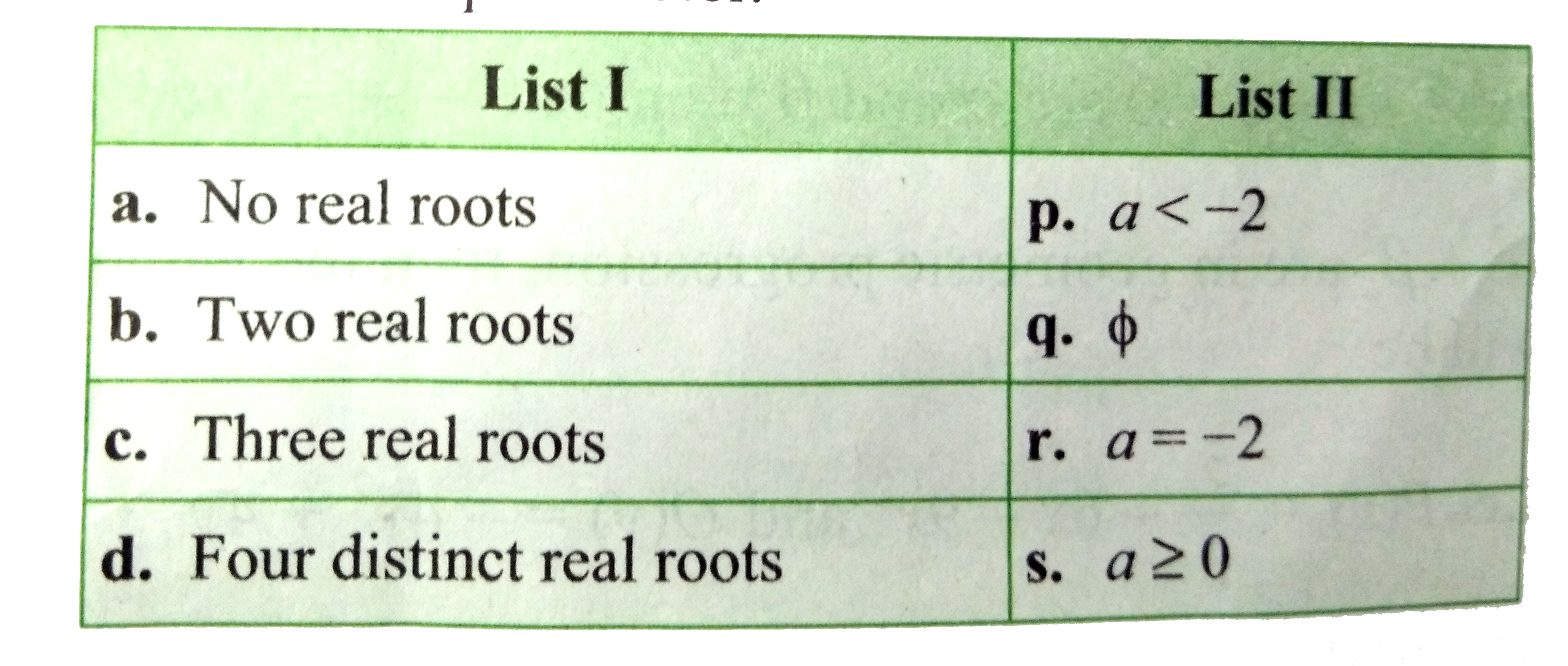If f(x)=ax2+bx+c , where a≠0,b,c∈ R , then which of
the following conditions implies that f(x) has real roots? Solution in Bengali
a+ b + c = 0
a and c are of opposite signs
4ac−b2<0
a and b are of opposite signs
The correct Answer is:1,2,3,
(1) If f(1)=0⇒a+b+c=0
so, roots are real.
(2) D=b2−4ac
If ac<0⇒b2−4ac>0
(3) 4ac−b2<0⇒b2−4ac>0
So, roota are real .
This is not the sufficients condition
Topper's Solved these Questions
- THEORY OF EQUATIONSBOOK - CENGAGE PUBLICATIONCHAPTER - THEORY OF EQUATIONSEXERCISE - Linked Comprechension Type
37 Videos
- THEORY OF EQUATIONSBOOK - CENGAGE PUBLICATIONCHAPTER - THEORY OF EQUATIONSEXERCISE - MATRIX MATCH TYPE
6 Videos
- THEORY OF EQUATIONSBOOK - CENGAGE PUBLICATIONCHAPTER - THEORY OF EQUATIONSEXERCISE - Single Correct Answer Type : Exercise
89 Videos
- STRAIGHT LINESBOOK - CENGAGE PUBLICATIONCHAPTER - STRAIGHT LINESEXERCISE - ARCHIVES (NUMERICAL VALUE TYPE)
1 Videos
- THREE DIMENSIONAL GEOMETRYBOOK - CENGAGE PUBLICATIONCHAPTER - THREE DIMENSIONAL GEOMETRYEXERCISE - All Questions
291 Videos
Similar Questions
Consider an unknow polynomial which divided by (x−3) and (x−4) leaves remainder 2 and 1, respectively. Let R(x) be the remainder when this polynomial is divided by (x−3)(x−4).
If equations R(x)=x2+ax+1 has two distint real roots, then exhaustive values of a are.
View SolutionMatch the following for the equation x2+a|x|+1=0 where, a is a parameter.

View SolutionThe value of expression x4−8x3+18x2−8x+2 when x=2+√3
View SolutionFor a point P in the plane, let d1(P)andd2(P) be the distances of the point P from the lines x−y=0andx+y=0 respectively. The area of the region R consisting of all points P lying in the first quadrant of the plane and satisfying 2≤d1(P)+d2(P)≤4, is
View SolutionFind the angle between the line whose direction cosines are given by l+m+n=0andl2+m2−n2=0.
View SolutionIf f(x)=ax2+bx+c,g(x)=−ax2+bx+c,whereac≠0, then prove that f(x)g(x)=0 has at least two real roots.
View SolutionLet f(x)=ax^(2)+bx+c, where a,b,c,in R and a!=0, If f(2)=3f(1) and 3 is a roots of the equation f(x)=0, then the other roots of f(x)=0 is
View SolutionConsider the quadratic function f(x)=ax^(2)+bx+c where a,b,c in R and a!=0, such that f(x)=f(2-x) for all real number x. The sum of the roots of f(x) is
View Solutiona,b,c,∈R,a≠0 and the quadratic equation ax2+bx+c=0 has no real roots, then which one of the following is not true?
View SolutionLet f(x)=ax2−bx+c2,b≠0andf(x)≠0 for all x∈R. Then
View SolutionIf f(x)=ax2+bc+c , where a≠0,b,c∈ R , then which of
the following conditions implies that f(x) has real roots?
View SolutionLet f(x)=ax2+bx+c,a>=andf(2−x)=f(2+x)∀x∈Randf(x)=0 has 2 distinct real roots, then which of the following is true ?
View SolutionLet f(x)=ax2+bx+c,a≠0, such the f(−1−x)=f(−1+x)∀x∈R. Also given that f(x)=0 has no real roots and 4a+b>0.
Let p=b−4a,q=2a+b, then pq is:
View SolutionIf f(x)=ax2+bx+c,g(x)=−ax2+bx+c where ac≠0 then f(x).g(x)=0 has
View SolutionFor the function f(x)=ax2+bx+c,a≠0 , the sum of the roots is equal to the product of the roots . Which could be f(x) ?
View SolutionLet f(x)=ax2−bx+c2,b≠0andf(x)≠0 for all x∈R. Then
View Solution
